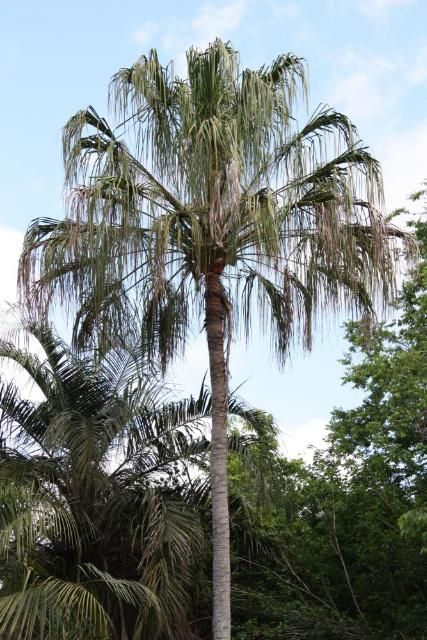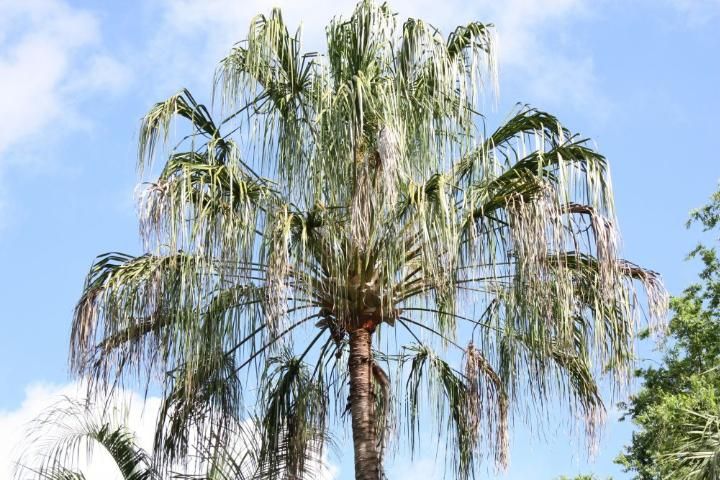Family
Arecaceae, palm family.
Genus
Livistona is the Latin term for "Livingston," the Scottish city where in 1670 Patrick Murray, a gardener and nobleman, helped found the Edinburgh Botanic Garden with his collection of plants.
Species
The name decipiens, Latin for "deceiving" or "deceptive," is thought to have been applied to this palm after discovering that it had been misidentified and cultivated in France as another plant species.
Common Name
Ribbon Fan Palm
The common name of this palm comes from the physiological characteristics of its leaves, which split into many segments or lobes from the middle of the leaf and look like ribbons dangling from a hand-held fan.
Description
This palm is endemic to Australia and grows along forest edges and coastal swamps in eastern Queensland. In the United States, it can survive where temperatures do not drop below 20°F, such as in parts of Florida, Texas, Arizona, and California. It prefers full sun but can tolerate partial shade, and it can reach heights of 30 to 50 feet. Leaves are costapalmate, which means that they have a prominent mid-vein and a common point on the leaf where it lobes or splits. The split occurs in the middle of the leaf and continues to its tip. The area below the split is the part that resembles a hand-held fan. Individual leaves are large with widths ranging from 7 to 9 feet. Each leaf can reach a length of 4 to 6 feet and is attached to a 6-foot petiole that is armed with short, sharp teeth along its margin. Leaves are dark green on their topside and grayish green on their underside. The trunk is light brown with dense leaf base scars encircling it and can reach a diameter of up to 10 inches. Male and female flowers appear on branching flower inflorescences that emerge among the leaves. The inflorescences are 4 to 9 feet long and bear yellow blooms. The fruit is 1/2 inch to 5/8 inches in diameter and turns black when ripe.

Credit: CA Floristics, (CC BY-NC-ND 2.0)

Credit: CA Floristics, (CC BY-NC-ND 2.0)
Allergen
Members of this genus cause minimal to no allergies.
Applications
Horticultural
The ribbon fan palm is a tall and stately tree with draping leaves that can add a graceful touch to any yard. It can be planted as a single specimen but is more striking if planted in groups of three. The ribbon fan palm is tolerant to drought and grows on a wide variety of well-drained soils, but it grows fastest and looks healthiest when it is watered regularly. Though it can survive indoors when given plenty of light and space, it is best to grow this palm outdoors.
References
Coombes, A. 1994. Dictionary of plant names: Botanical names and their common name equivalents. Portland, OR: Timber Press.
Floridata.com. 1999. Livistona dicipiens, Retrieved from http://www.floridata.com/ref/L/livi_dec.cfm
Gledhill, D. 1989. The names of plants (2nd ed.). Cambridge: Cambridge University Press.
Meerow, A. W. 2004. Betrock's guide to landscape palms (9th ed.). Hollywood, FL: Betrock Information Systems.
Ogren, T. L. 2000. Allergy-free gardening: The revolutionary guide to healthy landscaping. Berkeley, CA: Ten Speed Press.
Riffle, R. L. and P. Craft. 2003. An encyclopedia of cultivated palms. Portland, OR: Timber Press, Inc.